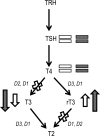Effect of tight glucose control with insulin on the thyroid axis of critically ill children and its relation with outcome
- PMID: 22872689
- PMCID: PMC3462949
- DOI: 10.1210/jc.2012-2240
Effect of tight glucose control with insulin on the thyroid axis of critically ill children and its relation with outcome
Abstract
Context: Tight glucose control (TGC) to normal-for-age fasting blood glucose levels reduced morbidity and mortality in surgical adult and pediatric intensive care unit (ICU) patients. In adults, TGC did not affect the illness-induced alterations in thyroid hormones. With better feeding in children than in adult patients, we hypothesized that TGC in pediatric ICU patients reactivates the thyroid axis.
Objective: The aim of this study was to assess the impact of TGC on the thyroid axis in pediatric ICU patients and to investigate how these changes affect the TGC outcome benefit.
Design and patients: We conducted a preplanned analysis of all patients not treated with thyroid hormone, dopamine, or corticosteroids who were included in a randomized controlled trial on TGC (n=700).
Main outcome measures: Serum TSH, T4, T3, and rT3 were measured upon admission and on ICU day 3 or the last ICU day for patients discharged earlier. Changes from baseline were compared for the TGC and usual care groups. The impact on the outcome benefit of TGC was assessed with multivariable Cox proportional hazard analysis, correcting for baseline risk factors.
Results: TGC further lowered the T)/rT3 ratio (P=0.03), whereas TSH (P=0.09) and T4 (P=0.3) were unaltered. With TGC, the likelihood of earlier live discharge from the ICU was 19% higher at any time (hazard ratio, 1.190; 95% confidence interval, 1.010-1.407; P=0.03). This benefit was statistically explained by the further reduction of T3/rT3 with TGC because an increase in T3/rT3 was strongly associated with a lower likelihood for earlier live discharge (hazard ratio per unit increase, 0.863; 95% confidence interval, 0.806-0.927; P<0.0001).
Conclusions: TGC further accentuated the peripheral inactivation of thyroid hormone. This effect, mimicking a fasting response, statistically explained part of the clinical outcome benefit of TGC.
Trial registration: ClinicalTrials.gov NCT00214916.
Figures


Similar articles
-
Non-Thyroidal Illness Syndrome in Critically Ill Children: Prognostic Value and Impact of Nutritional Management.Thyroid. 2019 Apr;29(4):480-492. doi: 10.1089/thy.2018.0420. Epub 2019 Mar 11. Thyroid. 2019. PMID: 30760183 Free PMC article. Clinical Trial.
-
Tight glycemic control in critically ill pediatric patients: a meta-analysis and systematic review of randomized controlled trials.Pediatr Res. 2018 May;83(5):930-935. doi: 10.1038/pr.2017.310. Epub 2018 Mar 28. Pediatr Res. 2018. PMID: 29244792
-
Impact of early nutrient restriction during critical illness on the nonthyroidal illness syndrome and its relation with outcome: a randomized, controlled clinical study.J Clin Endocrinol Metab. 2013 Mar;98(3):1006-13. doi: 10.1210/jc.2012-2809. Epub 2013 Jan 24. J Clin Endocrinol Metab. 2013. PMID: 23348400 Clinical Trial.
-
Glucose control in the intensive care unit.Crit Care Med. 2009 May;37(5):1769-76. doi: 10.1097/CCM.0b013e3181a19ceb. Crit Care Med. 2009. PMID: 19325461 Review.
-
Design and rationale of Heart and Lung Failure - Pediatric INsulin Titration Trial (HALF-PINT): A randomized clinical trial of tight glycemic control in hyperglycemic critically ill children.Contemp Clin Trials. 2017 Feb;53:178-187. doi: 10.1016/j.cct.2016.12.023. Epub 2016 Dec 30. Contemp Clin Trials. 2017. PMID: 28042054 Free PMC article. Clinical Trial.
Cited by
-
Thyroid function in critically ill patients.Lancet Diabetes Endocrinol. 2015 Oct;3(10):816-25. doi: 10.1016/S2213-8587(15)00225-9. Epub 2015 Jun 10. Lancet Diabetes Endocrinol. 2015. PMID: 26071885 Free PMC article. Review.
-
Prevalence and clinical profile of abnormal glucose in first-episode and drug-naïve patients with major depressive disorder with comorbid abnormal thyroid function: a large-scale cross-sectional study.BMC Psychiatry. 2023 May 24;23(1):362. doi: 10.1186/s12888-023-04842-5. BMC Psychiatry. 2023. PMID: 37226146 Free PMC article.
-
Non-Thyroidal Illness Syndrome in Critically Ill Children: Prognostic Value and Impact of Nutritional Management.Thyroid. 2019 Apr;29(4):480-492. doi: 10.1089/thy.2018.0420. Epub 2019 Mar 11. Thyroid. 2019. PMID: 30760183 Free PMC article. Clinical Trial.
-
Tight glycemic control in critically ill pediatric patients: a meta-analysis and systematic review of randomized controlled trials.Pediatr Res. 2018 May;83(5):930-935. doi: 10.1038/pr.2017.310. Epub 2018 Mar 28. Pediatr Res. 2018. PMID: 29244792
-
An update on non-thyroidal illness syndrome.J Endocrinol Invest. 2021 Aug;44(8):1597-1607. doi: 10.1007/s40618-020-01482-4. Epub 2020 Dec 15. J Endocrinol Invest. 2021. PMID: 33320308 Free PMC article. Review.
References
-
- Gardner DF, Kaplan MM, Stanley CA, Utiger RD. 1979. Effect of tri-iodothyronine replacement on the metabolic and pituitary responses to starvation. N Engl J Med 300:579–584 - PubMed
-
- Hugues JN, Burger AG, Pekary AE, Hershman JM. 1984. Rapid adaptations of serum thyrotrophin, triiodothyronine and reverse triiodothyronine levels to short-term starvation and refeeding. Acta Endocrinol (Copenh) 105:194–199 - PubMed
-
- Van den Berghe G, de Zegher F, Bouillon R. 1998. Clinical review 95: acute and prolonged critical illness as different neuroendocrine paradigms. J Clin Endocrinol Metab 83:1827–1834 - PubMed
-
- van der Poll T, Romijn JA, Wiersinga WM, Sauerwein HP. 1990. Tumor necrosis factor: a putative mediator of the sick euthyroid syndrome in man. J Clin Endocrinol Metab 71:1567–1572 - PubMed
-
- Peeters RP, Wouters PJ, Kaptein E, van Toor H, Visser TJ, Van den Berghe G. 2003. Reduced activation and increased inactivation of thyroid hormone in tissues of critically ill patients. J Clin Endocrinol Metab 88:3202–3211 - PubMed
Publication types
MeSH terms
Substances
Associated data
LinkOut - more resources
Full Text Sources
Other Literature Sources
Medical

